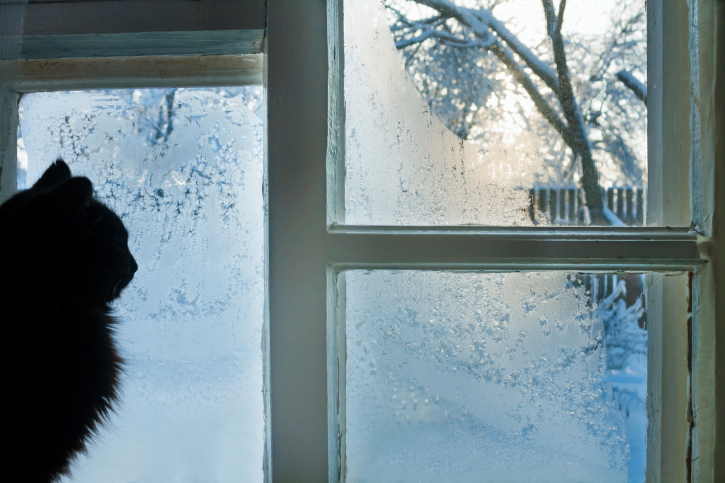 In the cold winter months, you’ll probably want to be outside enjoying the snow when you get a chance – perhaps building a snowman or having a snowball fight with the kids. However, you’ll get cold, and you’ll want to come inside to your well-heated home.
In the cold winter months, you’ll probably want to be outside enjoying the snow when you get a chance – perhaps building a snowman or having a snowball fight with the kids. However, you’ll get cold, and you’ll want to come inside to your well-heated home.
While you may have dealt with insulating your attic, walls and other areas of your home, if you’ve neglected your windows you may find that they become a source of very cold drafts.
In today’s blog post we’ll share a quick three-step guide to weatherizing your windows which will keep you warmer and help to prevent wasted energy and high heating bills.
Between Window Frames and Walls
The first step to weatherizing your windows is to check for spaces in between the window frames and the windows. You can often see any gaps clearly as they will allow you to see straight outside. If you’re dealing with small gaps you can use caulking as a temporary solution.
If you’re dealing with larger gaps, you’ll want to have professionals come in to repair or rebuild the wall.
Between Window Frames and Windows
If you have windows that can be open and closed, you’re going to need to check these to ensure they seal tightly and that the weather-stripping hasn’t worn away. Weather-stripping is typically sold in rolls, and most types have at least one adhesive side so that you can quickly apply it to your windows and frames. Note that there are different types of weather-stripping on the market, so be sure to purchase a type that will work with your windows.
The Window Panes
The window panes themselves can be used to your advantage. On sunny winter days, you can open the windows and let the sunshine in to warm up your home. At night, close the curtains or blinds to help make a sort of insulation to keep out the cold. The thicker the curtains or drapes are, the more they will help insulate your home and prevent heat loss through your windows.
The benefits of weatherizing your windows will serve you well past this winter if done right. Don’t forget that doing the opposite with curtains or blinds in the summer will help keep your home cool, and the value of a house goes up when these kinds of details are covered. When you’re ready to sell your home, be sure to contact your local real estate agent and they’ll be happy to assist.
 For those who are looking for a new home, it is important to take the time to get this decision right. For a lot of people, a home is the most valuable investment they are ever going to make. As a result, it is critical to evaluate all of the options that are available. That way, everyone will get the most out of their time. What about setting a budget? How important is this and should people think about going over it?
For those who are looking for a new home, it is important to take the time to get this decision right. For a lot of people, a home is the most valuable investment they are ever going to make. As a result, it is critical to evaluate all of the options that are available. That way, everyone will get the most out of their time. What about setting a budget? How important is this and should people think about going over it? For those who are thinking about buying or selling a home during the pandemic, they may feel like this is a difficult task. Even though it is true that this is going to be a challenge, people are able to increase their success rate by adapting to a new environment. When it comes to buying or selling a home during the pandemic, there are a few tips that everyone should keep in mind.
For those who are thinking about buying or selling a home during the pandemic, they may feel like this is a difficult task. Even though it is true that this is going to be a challenge, people are able to increase their success rate by adapting to a new environment. When it comes to buying or selling a home during the pandemic, there are a few tips that everyone should keep in mind. Are you thinking about selling a home that you have rented out for some additional revenue? If so, you’re likely trying to discern how to best inform the current tenants and conduct the sales process in a way that works well for all of the parties involved. In today’s blog post we’ll explore how to sell your home while you’re renting it out to tenants and share three tips that can make the process a bit easier.
Are you thinking about selling a home that you have rented out for some additional revenue? If so, you’re likely trying to discern how to best inform the current tenants and conduct the sales process in a way that works well for all of the parties involved. In today’s blog post we’ll explore how to sell your home while you’re renting it out to tenants and share three tips that can make the process a bit easier. Last week’s economic news included reports from Case-Shiller Home Price Indices and data on pending home sales. No weekly data on jobless claims were released due to the New Year holiday, but Freddie Mac did issue its weekly report on average mortgage rates.
Last week’s economic news included reports from Case-Shiller Home Price Indices and data on pending home sales. No weekly data on jobless claims were released due to the New Year holiday, but Freddie Mac did issue its weekly report on average mortgage rates. Moving is not exactly enjoyable at any time of the year, but it can be especially stressful in the winter. Moving all of your items when it is snowing and blowing outside makes things a lot tougher. However, if you prepare accordingly and have the right attitude, you’ll find that your move will go much smoother. Here are five relocation tips that will help ease the stress of a move.
Moving is not exactly enjoyable at any time of the year, but it can be especially stressful in the winter. Moving all of your items when it is snowing and blowing outside makes things a lot tougher. However, if you prepare accordingly and have the right attitude, you’ll find that your move will go much smoother. Here are five relocation tips that will help ease the stress of a move.